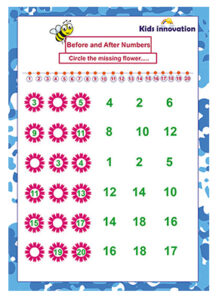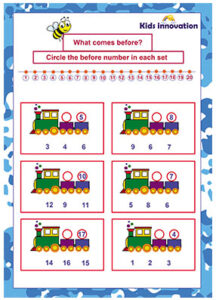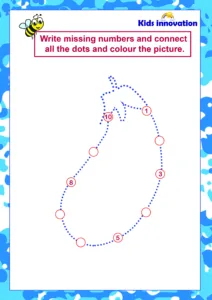Preschool Math Worksheets

Introduction:
Welcome to a colorful world of early learning! In this blog post, we delve into the realm of educational fun with a focus on “preschool math worksheets.” Uncover engaging activities designed to spark curiosity and lay the foundation for numerical understanding in the young minds of preschoolers. Join us as we explore the exciting journey of learning through play and discover the magic of math at the preschool level.
Preschool math worksheets play a crucial role in early childhood education for several reasons:
Foundation for Mathematical Concepts: Preschool math worksheets introduce fundamental concepts like counting, number recognition, and basic operations. These are building blocks for more advanced mathematical skills.
Cognitive Development: Engaging with math worksheets helps develop cognitive skills such as problem-solving, critical thinking, and spatial awareness. These skills are important not only in math but in various aspects of life.
Language Development: Math involves its own language, and preschool math worksheets introduce children to math vocabulary. This can improve their overall language skills.

Fine Motor Skills: Completing worksheets often involves activities like coloring, tracing, and writing numbers. These activities help in the development of fine motor skills, which are essential for tasks like writing and drawing.
Preparation for School: Preschool math worksheets provide a structured way to prepare children for the formal education system. They become accustomed to learning in a classroom setting and following instructions.
Confidence Building: Successfully completing worksheets can boost a child’s confidence. This confidence extends beyond math and can positively impact their attitude towards learning in general.
Parent Involvement: Worksheets are often used in conjunction with parental guidance. This involvement not only reinforces learning but also strengthens the parent-child bond.
Readiness for Advanced Math: Early exposure to math through worksheets can prepare children for more complex math concepts in later grades. A strong foundation in preschool can lead to better performance in mathematics throughout school.

Real-World Application: Math is an essential life skill. Preschool math worksheets introduce children to practical applications of math, such as measuring, time-telling, and understanding money.
Critical Thinking: These worksheets encourage kids to think logically and solve problems independently, which is a valuable skill in any field of study or profession.
In summary, preschool math worksheets serve as a valuable educational tool to lay the groundwork for mathematical understanding and cognitive development, helping children succeed not only in math but in various aspects of their academic and personal lives.
Kindergarten mathematics forms the foundation for a child’s early numerical understanding and lays the groundwork for more complex mathematical concepts in the future. Here are some key aspects of kindergarten mathematics:

Counting: Kindergarteners learn to count from 1 to 10 and often beyond. They understand the concept of “one-to-one correspondence,” where each number corresponds to an object. Counting is an essential skill that helps children grasp the concept of quantity.
Number Recognition: Kindergarten students become familiar with numbers and how they look. They learn to recognize and write numbers, which is a crucial step towards understanding basic mathematical operations.
Basic Operations: While not delving into complex calculations, kindergarteners are introduced to basic mathematical operations, such as addition and subtraction, through simple, hands-on activities. They might use objects like blocks or counters to physically represent these operations.
Patterns: Recognizing and creating patterns is an important mathematical skill at this level. Kindergarteners may practice creating and identifying simple patterns, which helps develop their ability to make predictions and solve problems.

Measurement: Children in kindergarten begin to understand concepts of size, length, and weight. They might engage in activities that involve comparing and ordering objects by size.
Shapes and Geometry: Kindergarteners learn to identify and describe basic shapes, such as squares, circles, triangles, and rectangles. They also start to explore concepts related to geometry, like symmetry.
Data and Graphing: In a simplified manner, kindergarteners might collect and interpret data, such as tallying the number of students with specific characteristics (e.g., hair color) and creating basic bar graphs to represent this data.

Problem Solving: Problem-solving skills are nurtured in kindergarten mathematics. Students are encouraged to use their mathematical knowledge to solve everyday problems and puzzles.
Critical Thinking: While not explicitly taught, critical thinking is developed through mathematical activities. Kindergarteners learn to analyze information, make comparisons, and draw conclusions.
Conclusion:
Kindergarten mathematics education is designed to be hands-on, engaging, and fun to build a solid foundation for future mathematical learning. It’s crucial to ensure that children at this stage have a positive and enjoyable experience with math, setting the stage for their continued mathematical development.
What is the number that comes after 3 in the counting sequence?
A) 4
B) 5
C) 6
D) 7
How many sides does a square have?
A) 2
B) 3
C) 4
D) 5
Which of the following is a shape with three sides?
A) Square
B) Circle
C) Triangle
D) Rectangle

What is 2 + 3?
A) 4
B) 5
C) 6
D) 7
How many fingers are there on one hand?
A) 3
B) 4
C) 5
D) 6
SAVE PDF
Which number comes before 8 in the counting sequence?
A) 6
B) 7
C) 8
D) 9
How many legs does a dog have?
A) 2
B) 3
C) 4
D) 5

What shape does a traffic sign with three sides represent?
A) Square
B) Circle
C) Triangle
D) Rectangle
What comes after 9 in the counting sequence?
A) 10
B) 11
C) 12
D) 13
If you have 4 apples and you eat 2, how many apples do you have left?
A) 1
B) 2
C) 3
D) 4

What is the shape of a stop sign?
A) Square
B) Circle
C) Triangle
D) Octagon
How many sides does a circle have?
A) 0
B) 1
C) 2
D) 3
Which number is one less than 6?
A) 4
B) 5
C) 6
D) 7

If you have 2 red marbles and 3 blue marbles, how many marbles do you have in total?
A) 3
B) 4
C) 5
D) 6
How many corners does a rectangle have?
A) 1
B) 2
C) 3
D) 4
What is 10 divided by 2?
A) 2
B) 4
C) 6
D) 8
How many days are there in a week?
A) 5
B) 6
C) 7
D) 8
Which number is greater: 3 or 7?
A) 3
B) 7
C) They are equal
D) Can’t tell

If you add 1 and 2, what is the result?
A) 1
B) 2
C) 3
D) 4
Answer: C) 3
What is the shape of the moon when it is full?
A) Square
B) Circle
C) Triangle
D) Rectangle
For more Preschool Math Worksheets from Shutterstock click here
https://www.shutterstock.com/search/preschool-math-worksheet
 Skip to content
Skip to content 
1 thought on “Preschool Math Worksheets”